Switching Magnetic Properties by a Mechanical Motion
Abstract
1. Introduction
2. Spin State Change by Ligand Field Strength Modulation
3. Spin State Change by Coordination Number Modulation
4. Spin State Change by Exchange Interaction Modulation
5. Summary and Outlook
Acknowledgments
Conflicts of Interest
References
- Balzani, V.; Venturi, M.; Credi, A. Molecular Devices and Machines: Concepts and Perspectives for the Nanoworld; Wiley-VCH: Weinheim, Germany, 2008. [Google Scholar]
- Kay, E.R.; Leigh, D.A. Rise of the Molecular Machines. Angew. Chem. Int. Ed. 2015, 54, 10080–10088. [Google Scholar] [CrossRef] [PubMed]
- Sato, O.; Tao, J.; Zhang, Y.-Z. Control of Magnetic Properties through External Stimuli. Angew. Chem. Int. Ed. 2007, 46, 2152–2187. [Google Scholar] [CrossRef] [PubMed]
- Gutlich, P.; Garcia, Y.; Goodwin, H.A. Spin crossover phenomena in Fe(II) complexes. Chem. Soc. Rev. 2000, 29, 419–427. [Google Scholar] [CrossRef]
- Gütlich, P.; Hauser, A.; Spiering, H. Thermal and Optical Switching of Iron(II) Complexes. Angew. Chem. Int. Ed. 1994, 33, 2024–2054. [Google Scholar] [CrossRef]
- Bonnet, S.; Molnár, G.; Sanchez Costa, J.; Siegler, M.A.; Spek, A.L.; Bousseksou, A.; Fu, W.-T.; Gamez, P.; Reedijk, J. Influence of Sample Preparation, Temperature, Light, and Pressure on the Two-Step Spin Crossover Mononuclear Compound [Fe(bapbpy)(NCS)2]. Chem. Mater. 2009, 21, 1123–1136. [Google Scholar] [CrossRef]
- Bousseksou, A.; Molnár, G.; Matouzenko, G. Switching of Molecular Spin States in Inorganic Complexes by Temperature, Pressure, Magnetic Field and Light: Towards Molecular Devices. Eur. J. Inorg. Chem. 2004, 4353–4369. [Google Scholar] [CrossRef]
- Real, J.A.; Gaspar, A.B.; Munoz, M.C. Thermal, pressure and light switchable spin-crossover materials. Dalton Trans. 2005, 2062–2079. [Google Scholar] [CrossRef] [PubMed]
- Halcrow, M.A. Structure: Function relationships in molecular spin-crossover complexes. Chem. Soc. Rev. 2011, 40, 4119–4142. [Google Scholar] [CrossRef] [PubMed]
- Halcrow, M. The Effect of Ligand Design on Metal Ion Spin State—Lessons from Spin Crossover Complexes. Crystals 2016, 6, 58. [Google Scholar] [CrossRef]
- Senthil Kumar, K.; Ruben, M. Emerging trends in spin crossover (SCO) based functional materials and devices. Coord. Chem. Rev. 2017, 346, 176–205. [Google Scholar] [CrossRef]
- Sato, O. Photoinduced magnetization in molecular compounds. J. Photochem. Photobiol. C 2004, 5, 203–223. [Google Scholar] [CrossRef]
- Bleuzen, A.; Marvaud, V.; Mathoniere, C.; Sieklucka, B.; Verdaguer, M. Photomagnetism in Clusters and Extended Molecule-Based Magnets. Inorg. Chem. 2009, 48, 3453–3466. [Google Scholar] [CrossRef] [PubMed]
- Gatteschi, D.; Sessoli, R. Quantum Tunneling of Magnetization and Related Phenomena in Molecular Materials. Angew. Chem. Int. Ed. 2003, 42, 268–297. [Google Scholar] [CrossRef] [PubMed]
- Sessoli, R.; Powell, A.K. Strategies towards single molecule magnets based on lanthanide ions. Coord. Chem. Rev. 2009, 253, 2328–2341. [Google Scholar] [CrossRef]
- Brooker, S. Spin crossover with thermal hysteresis: Practicalities and lessons learnt. Chem. Soc. Rev. 2015, 44, 2880–2892. [Google Scholar] [CrossRef] [PubMed]
- Gaspar, A.B.; Seredyuk, M. Spin crossover in soft matter. Coord. Chem. Rev. 2014, 268, 41–58. [Google Scholar] [CrossRef]
- Gütlich, P.; Gaspar, A.B.; Garcia, Y. Spin state switching in iron coordination compounds. Beilstein J. Org. Chem. 2013, 9, 342–391. [Google Scholar] [CrossRef] [PubMed]
- Bousseksou, A.; Molnar, G.; Salmon, L.; Nicolazzi, W. Molecular spin crossover phenomenon: Recent achievements and prospects. Chem. Soc. Rev. 2011, 40, 3313–3335. [Google Scholar] [CrossRef] [PubMed]
- Khusniyarov, M.M. How to Switch Spin-Crossover Metal Complexes at Constant Room Temperature. Chem. Eur. J. 2016, 22, 15178–15191. [Google Scholar] [CrossRef] [PubMed]
- Craig, G.A.; Costa, J.S.; Roubeau, O.; Teat, S.J.; Shepherd, H.J.; Lopes, M.; Molnar, G.; Bousseksou, A.; Aromi, G. High-temperature photo-induced switching and pressure-induced transition in a cooperative molecular spin-crossover material. Dalton Trans. 2014, 43, 729–737. [Google Scholar] [CrossRef] [PubMed]
- Hauser, A. Light-Induced Spin Crossover and the High-Spin Low-Spin Relaxation. In Spin Crossover in Transition Metal Compounds II; Springer: Berlin/Heidelberg, Germany, 2004; Volume 234; pp. 155–198. [Google Scholar]
- Unruh, D.; Homenya, P.; Kumar, M.; Sindelar, R.; Garcia, Y.; Renz, F. Spin state switching of metal complexes by visible light or hard X-rays. Dalton Trans. 2016, 45, 14008–14018. [Google Scholar] [CrossRef] [PubMed]
- Mondal, A.; Li, Y.; Chamoreau, L.M.; Seuleiman, M.; Rechignat, L.; Bousseksou, A.; Boillot, M.L.; Lescouezec, R. Photo- and thermo-induced spin crossover in a cyanide-bridged {Mo(V)2Fe(II)2} rhombus molecule. Chem. Commun. 2014, 50, 2893–2895. [Google Scholar] [CrossRef] [PubMed]
- Halder, G.J.; Cameron, J.K.; Moubaraki, B.; Murray, K.S.; Cashion, J.D. Guest-Dependent Spin Crossover in a Nanoporous Molecular Framework Material. Science 2002, 298, 1762–1765. [Google Scholar] [CrossRef] [PubMed]
- Mahfoud, T.; Molnár, G.; Bonhommeau, S.; Cobo, S.; Salmon, L.; Demont, P.; Tokoro, H.; Ohkoshi, S.; Boukheddaden, K.; Bousseksou, A. Electric-Field-Induced Charge-Transfer Phase Transition: A Promising Approach Toward Electrically Switchable Devices. J. Am. Chem. Soc. 2009, 131, 15049–15054. [Google Scholar] [CrossRef] [PubMed]
- Coronado, E.; Giménez-López, M.C.; Levchenko, G.; Romero, F.M.; García-Baonza, V.; Milner, A.; Paz-Pasternak, M. Pressure-Tuning of Magnetism and Linkage Isomerism in Iron(II) Hexacyanochromate. J. Am. Chem. Soc. 2005, 127, 4580–4581. [Google Scholar] [CrossRef] [PubMed]
- Herrera, J.M.; Marvaud, V.; Verdaguer, M.; Marrot, J.; Kalisz, M.; Mathonière, C. Reversible Photoinduced Magnetic Properties in the Heptanuclear Complex [MoIV(CN)2(CNCuL)6]8+: A Photomagnetic High-Spin Molecule. Angew. Chem. Int. Ed. 2004, 43, 5468–5471. [Google Scholar] [CrossRef] [PubMed]
- Hilfiger, M.G.; Chen, M.; Brinzari, T.V.; Nocera, T.M.; Shatruk, M.; Petasis, D.T.; Musfeldt, J.L.; Achim, C.; Dunbar, K.R. An Unprecedented Charge Transfer Induced Spin Transition in an Fe–Os Cluster. Angew. Chem. Int. Ed. 2010, 49, 1410–1413. [Google Scholar] [CrossRef] [PubMed]
- Mondal, A.; Chamoreau, L.-M.; Li, Y.; Journaux, Y.; Seuleiman, M.; Lescouëzec, R. WCo Discrete Complex Exhibiting Photo- and Thermo-Induced Magnetisation. Chem. Eur. J. 2013, 19, 7682–7685. [Google Scholar] [CrossRef] [PubMed]
- Hozumi, T.; Hashimoto, K.; Ohkoshi, S.-I. Electrochemical Synthesis, Crystal Structure, and Photomagnetic Properties of a Three-Dimensional Cyano-Bridged Copper−Molybdenum Complex. J. Am. Chem. Soc. 2005, 127, 3864–3869. [Google Scholar] [CrossRef] [PubMed]
- Gu, Z.Z.; Sato, O.; Iyoda, T.; Hashimoto, K.; Fujishima, A. Spin Switching Effect in Nickel Nitroprusside: Design of a Molecular Spin Device Based on Spin Exchange Interaction. Chem. Mater. 1997, 9, 1092–1097. [Google Scholar] [CrossRef]
- Adams, D.M.; Hendrickson, D.N. Pulsed Laser Photolysis and Thermodynamics Studies of Intramolecular Electron Transfer in Valence Tautomeric Cobalt o-Quinone Complexes. J. Am. Chem. Soc. 1996, 118, 11515–11528. [Google Scholar] [CrossRef]
- Freedman, D.E.; Jenkins, D.M.; Iavarone, A.T.; Long, J.R. A Redox-Switchable Single-Molecule Magnet Incorporating [Re(CN)7]3. J. Am. Chem. Soc. 2008, 130, 2884–2885. [Google Scholar] [CrossRef] [PubMed]
- Norel, L.; Bernot, K.; Feng, M.; Roisnel, T.; Caneschi, A.; Sessoli, R.; Rigaut, S. A carbon-rich ruthenium decorated dysprosium single molecule magnet. Chem. Commun. 2012, 48, 3948–3950. [Google Scholar] [CrossRef] [PubMed]
- Norel, L.; Feng, M.; Bernot, K.; Roisnel, T.; Guizouarn, T.; Costuas, K.; Rigaut, S. Redox Modulation of Magnetic Slow Relaxation in a 4f-Based Single-Molecule Magnet with a 4d Carbon-Rich Ligand. Inorg. Chem. 2014, 53, 2361–2363. [Google Scholar] [CrossRef] [PubMed]
- Fortier, S.; Le Roy, J.J.; Chen, C.-H.; Vieru, V.; Murugesu, M.; Chibotaru, L.F.; Mindiola, D.J.; Caulton, K.G. A Dinuclear Cobalt Complex Featuring Unprecedented Anodic and Cathodic Redox Switches for Single-Molecule Magnet Activity. J. Am. Chem. Soc. 2013, 135, 14670–14678. [Google Scholar] [CrossRef] [PubMed]
- Nihei, M.; Okamoto, Y.; Sekine, Y.; Hoshino, N.; Shiga, T.; Liu, I.P.-C.; Oshio, H. A Light-Induced Phase Exhibiting Slow Magnetic Relaxation in a Cyanide-Bridged [Fe4Co2] Complex. Angew. Chem. Int. Ed. 2012, 51, 6361–6364. [Google Scholar] [CrossRef] [PubMed]
- Sato, O. Optically Switchable Molecular Solids: Photoinduced Spin-Crossover, Photochromism, and Photoinduced Magnetization. Acc. Chem. Res. 2003, 36, 692–700. [Google Scholar] [CrossRef] [PubMed]
- Ohkoshi, S.; Tokoro, H. Photomagnetism in Cyano-Bridged Bimetal Assemblies. Acc. Chem. Res. 2012, 45, 1749–1758. [Google Scholar] [CrossRef] [PubMed]
- Boillot, M.-L.; Zarembowitch, J.; Sour, A. Ligand-driven light-induced spin change (LD-LISC): A promising photomagnetic effect. Top. Curr. Chem. 2004, 234, 261–276. [Google Scholar]
- Roux, C.; Zarembowitch, J.; Gallois, B.; Granier, T.; Claude, R. Toward Ligand-Driven Light-Induced Spin Changing. Influence of the Configuration of 4 Styrylpyridine (stpy) on the Magnetic Properties of FeII(stpy)4(NCS)2 Complexes. Crystal Structures of the Spin-Crossover Species Fe(trans-stpy)4(NCS)2 and of the High-Spin Species Fe(cis-stpy)4(NCS)2. Inorg. Chem. 1994, 33, 2273–2279. [Google Scholar]
- Boillot, M.-L.; Roux, C.; Audière, J.-P.; Dausse, A.; Zarembowitch, J. Ligand-Driven Light-Induced Spin Change in Transition-Metal Complexes: Selection of an Appropriate System and First Evidence of the Effect, in FeII(4-styrylpyridine)4(NCBPh3)2. Inorg. Chem. 1996, 35, 3975–3980. [Google Scholar] [CrossRef] [PubMed]
- Boillot, M.-L.; Chantraine, S.; Zarembowitch, J.; Lallemand, J.-Y.; Prunet, J. First ligand-driven light-induced spin change atroomtemperature in a transition-metal molecular compound. New J. Chem. 1999, 23, 179–184. [Google Scholar] [CrossRef]
- Hasegawa, Y.; Kume, S.; Nishihara, H. Reversible light-induced magnetization change in an azobenzene-attached pyridylbenzimidazole complex of iron(II) at room temperature. Dalton Trans. 2009, 280–284. [Google Scholar] [CrossRef] [PubMed]
- Boillot, M.L.; Pillet, S.; Tissot, A.; Rivière, E.; Claiser, N.; Lecomte, C. Ligand-Driven Light-Induced Spin Change Activity and Bidirectional Photomagnetism of Styrylpyridine Iron(II) Complexes in Polymeric Media. Inorg. Chem. 2009, 48, 4729–4736. [Google Scholar] [CrossRef] [PubMed]
- Takahashi, K.; Hasegawa, Y.; Sakamoto, R.; Nishikawa, M.; Kume, S.; Nishibori, E.; Nishihara, H. Solid-State Ligand-Driven Light-Induced Spin Change at Ambient Temperatures in Bis(dipyrazolylstyrylpyridine)iron(II) Complexes. Inorg. Chem. 2012, 51, 5188–5198. [Google Scholar] [CrossRef] [PubMed]
- Hasegawa, Y.; Takahashi, K.; Kume, S.; Nishihara, H. Complete solid state photoisomerization of bis(dipyrazolylstyrylpyridine)iron(II) to change magnetic properties. Chem. Commun. 2011, 47, 6846–6848. [Google Scholar] [CrossRef] [PubMed]
- Rösner, B.; Milek, M.; Witt, A.; Gobaut, B.; Torelli, P.; Fink, R.H.; Khusniyarov, M.M. Reversible Photoswitching of a Spin-Crossover Molecular Complex in the Solid State at Room Temperature. Angew. Chem. Int. Ed. 2015, 54, 12976–12980. [Google Scholar] [CrossRef] [PubMed]
- Milek, M.; Heinemann, F.W.; Khusniyarov, M.M. Spin Crossover Meets Diarylethenes: Efficient Photoswitching of Magnetic Properties in Solution at Room Temperature. Inorg. Chem. 2013, 52, 11585–11592. [Google Scholar] [CrossRef] [PubMed]
- Nihei, M.; Suzuki, Y.; Kimura, N.; Kera, Y.; Oshio, H. Bidirectional Photomagnetic Conversions in a Spin-Crossover Complex with a Diarylethene Moiety. Chem. Eur. J. 2013, 19, 6946–6949. [Google Scholar] [CrossRef] [PubMed]
- Thies, S.; Sell, H.; Schütt, C.; Bornholdt, C.; Näther, C.; Tuczek, F.; Herges, R. Light-Induced Spin Change by Photodissociable External Ligands: A New Principle for Magnetic Switching of Molecules. J. Am. Chem. Soc. 2011, 133, 16243–16250. [Google Scholar] [CrossRef] [PubMed]
- Venkataramani, S.; Jana, U.; Dommaschk, M.; Sonnichsen, F.D.; Tuczek, F.; Herges, R. Magnetic bistability of molecules in homogeneous solution at room temperature. Science 2011, 331, 445–448. [Google Scholar] [CrossRef] [PubMed]
- Dommaschk, M.; Schutt, C.; Venkataramani, S.; Jana, U.; Nather, C.; Sonnichsen, F.D.; Herges, R. Rational design of a room temperature molecular spin switch. The light-driven coordination induced spin state switch (LD-CISSS) approach. Dalton Trans. 2014, 43, 17395–17405. [Google Scholar] [CrossRef] [PubMed]
- Dommaschk, M.; Peters, M.; Gutzeit, F.; Schütt, C.; Näther, C.; Sönnichsen, F.D.; Tiwari, S.; Riedel, C.; Boretius, S.; Herges, R. Photoswitchable Magnetic Resonance Imaging Contrast by Improved Light-Driven Coordination-Induced Spin State Switch. J. Am. Chem. Soc. 2015, 137, 7552–7555. [Google Scholar] [CrossRef] [PubMed]
- Schütt, C.; Heitmann, G.; Wendler, T.; Krahwinkel, B.; Herges, R. Design and Synthesis of Photodissociable Ligands Based on Azoimidazoles for Light-Driven Coordination-Induced Spin State Switching in Homogeneous Solution. J. Org. Chem. 2016, 81, 1206–1215. [Google Scholar] [CrossRef] [PubMed]
- Heitmann, G.; Schütt, C.; Herges, R. Spin State Switching in Solution with an Azoimidazole-Functionalized Nickel(II)-Porphyrin. Eur. J. Org. Chem. 2016, 2016, 3817–3823. [Google Scholar] [CrossRef]
- Heitmann, G.; Schutt, C.; Grobner, J.; Huber, L.; Herges, R. Azoimidazole functionalized Ni-porphyrins for molecular spin switching and light responsive MRI contrast agents. Dalton Trans. 2016, 45, 11407–11412. [Google Scholar] [CrossRef] [PubMed]
- Nowak, R.; Prasetyanto, E.A.; De Cola, L.; Bojer, B.; Siegel, R.; Senker, J.; Rossler, E.; Weber, B. Proton-driven coordination-induced spin state switch (PD-CISSS) of Iron(II) complexes. Chem. Commun. 2017, 53, 971–974. [Google Scholar] [CrossRef] [PubMed]
- Matsuda, K.; Irie, M. A Diarylethene with Two Nitronyl Nitroxides: Photoswitching of Intramolecular Magnetic Interaction. J. Am. Chem. Soc. 2000, 122, 7195–7201. [Google Scholar] [CrossRef]
- Fetoh, A.; Cosquer, G.; Morimoto, M.; Irie, M.; El-Gammal, O.; El-Reash, G.A.; Breedlove, B.K.; Yamashita, M. Photo-activation of Single Molecule Magnet Behavior in a Manganese-based Complex. Sci. Rep. 2016, 6, 23785. [Google Scholar] [CrossRef] [PubMed]
- Kaneko, T.; Abe, H.; Teraguchi, M.; Aoki, T. Folding-Induced Through-Space Magnetic Interaction of Poly(1,3-phenyleneethynylene)-Based Polyradicals. Macromolecules 2013, 46, 2583–2589. [Google Scholar] [CrossRef]
- Wang, J.; Hou, L.; Browne, W.R.; Feringa, B.L. Photoswitchable intramolecular through-space magnetic interaction. J. Am. Chem. Soc. 2011, 133, 8162–8164. [Google Scholar] [CrossRef] [PubMed]
- Bleve, V.; Schäfer, C.; Franchi, P.; Silvi, S.; Mezzina, E.; Credi, A.; Lucarini, M. Reversible Mechanical Switching of Magnetic Interactions in a Molecular Shuttle. ChemistryOpen 2015, 4, 18–21. [Google Scholar] [CrossRef] [PubMed]
- Doistau, B.; Tron, A.; Denisov, S.A.; Jonusauskas, G.; McClenaghan, N.D.; Gontard, G.; Marvaud, V.; Hasenknopf, B.; Vives, G. Terpy(Pt–salphen)2 Switchable Luminescent Molecular Tweezers. Chem. Eur. J. 2014, 20, 15799–15807. [Google Scholar] [CrossRef] [PubMed]
- Doistau, B.; Rossi-Gendron, C.; Tron, A.; McClenaghan, N.D.; Chamoreau, L.-M.; Hasenknopf, B.; Vives, G. Switchable platinum-based tweezers with Pt–Pt bonding and selective luminescence quenching. Dalton Trans. 2015, 44, 8543–8551. [Google Scholar] [CrossRef] [PubMed]
- Doistau, B.; Cantin, J.-L.; Chamoreau, L.-M.; Marvaud, V.; Hasenknopf, B.; Vives, G. Mechanical switching of magnetic interaction by tweezers-type complex. Chem. Commun. 2015, 51, 12916–12919. [Google Scholar] [CrossRef] [PubMed]
- Doistau, B.; Benda, L.; Cantin, J.-L.; Chamoreau, L.-M.; Ruiz, E.; Marvaud, V.; Hasenknopf, B.; Vives, G. Six States Switching of Redox-Active Molecular Tweezers by Three Orthogonal Stimuli. J. Am. Chem. Soc. 2017, 139, 9213–9220. [Google Scholar] [CrossRef] [PubMed]
- Shepherd, H.J.; Gural’skiy, I.Y.A.; Quintero, C.M.; Tricard, S.; Salmon, L.; Molnár, G.; Bousseksou, A. Molecular actuators driven by cooperative spin-state switching. Nat. Commun. 2013, 4, 2607. [Google Scholar] [CrossRef] [PubMed]
- Cornia, A.; Seneor, P. The molecular way. Nat. Mater. 2017, 16, 505–506. [Google Scholar] [CrossRef] [PubMed]
- Ferrando-Soria, J.; Vallejo, J.; Castellano, M.; Martínez-Lillo, J.; Pardo, E.; Cano, J.; Castro, I.; Lloret, F.; Ruiz-García, R.; Julve, M. Molecular magnetism, quo vadis? A historical perspective from a coordination chemist viewpoint. Coord. Chem. Rev. 2017, 339, 17–103. [Google Scholar] [CrossRef]
- Estrader, M.; Salinas Uber, J.; Barrios, L.A.; Garcia, J.; Lloyd-Williams, P.; Roubeau, O.; Teat, S.J.; Aromí, G. A Magneto-optical Molecular Device: Interplay of Spin Crossover, Luminescence, Photomagnetism, and Photochromism. Angew. Chem. Int. Ed. 2017, 56, 15622–15627. [Google Scholar] [CrossRef] [PubMed]
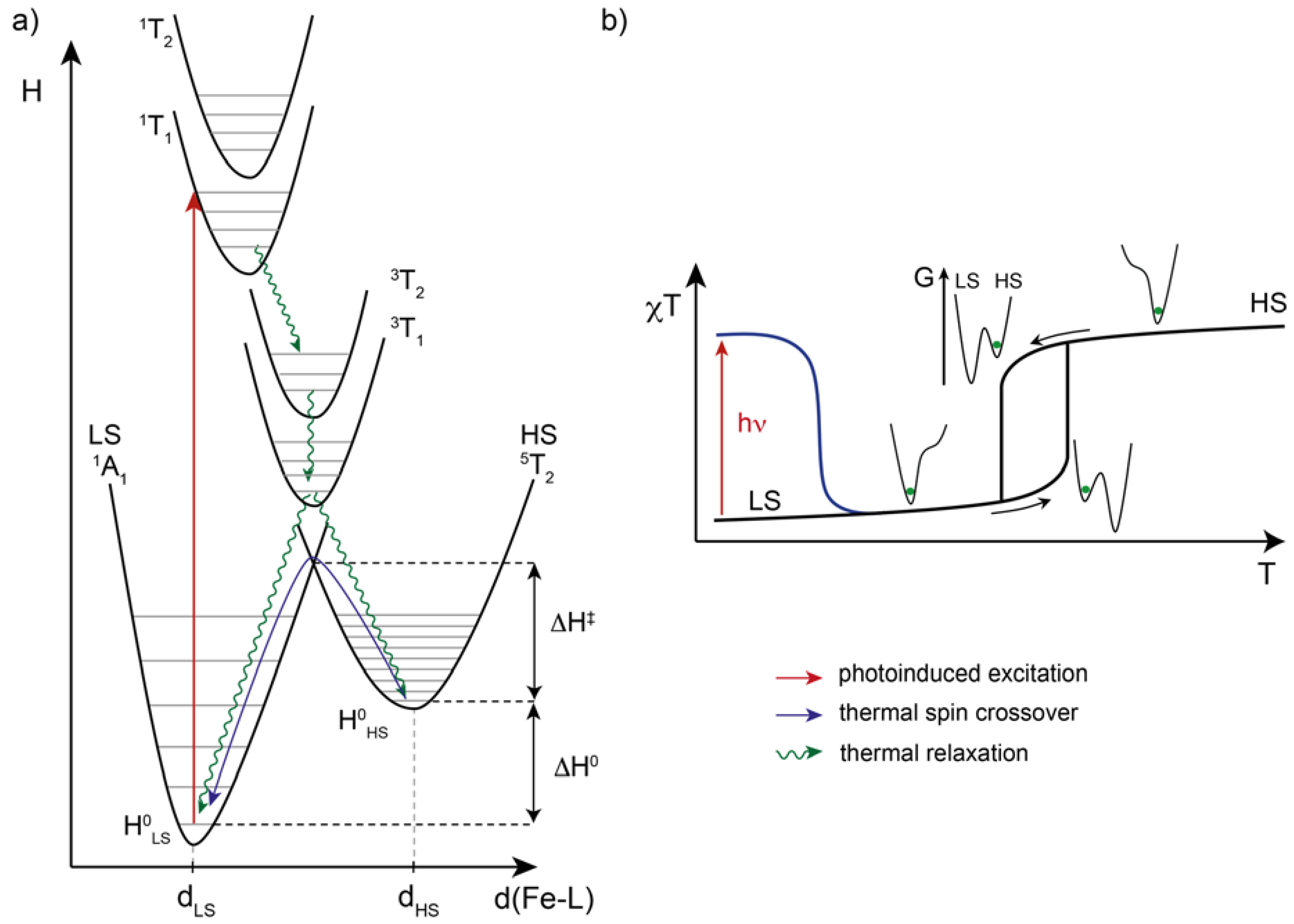


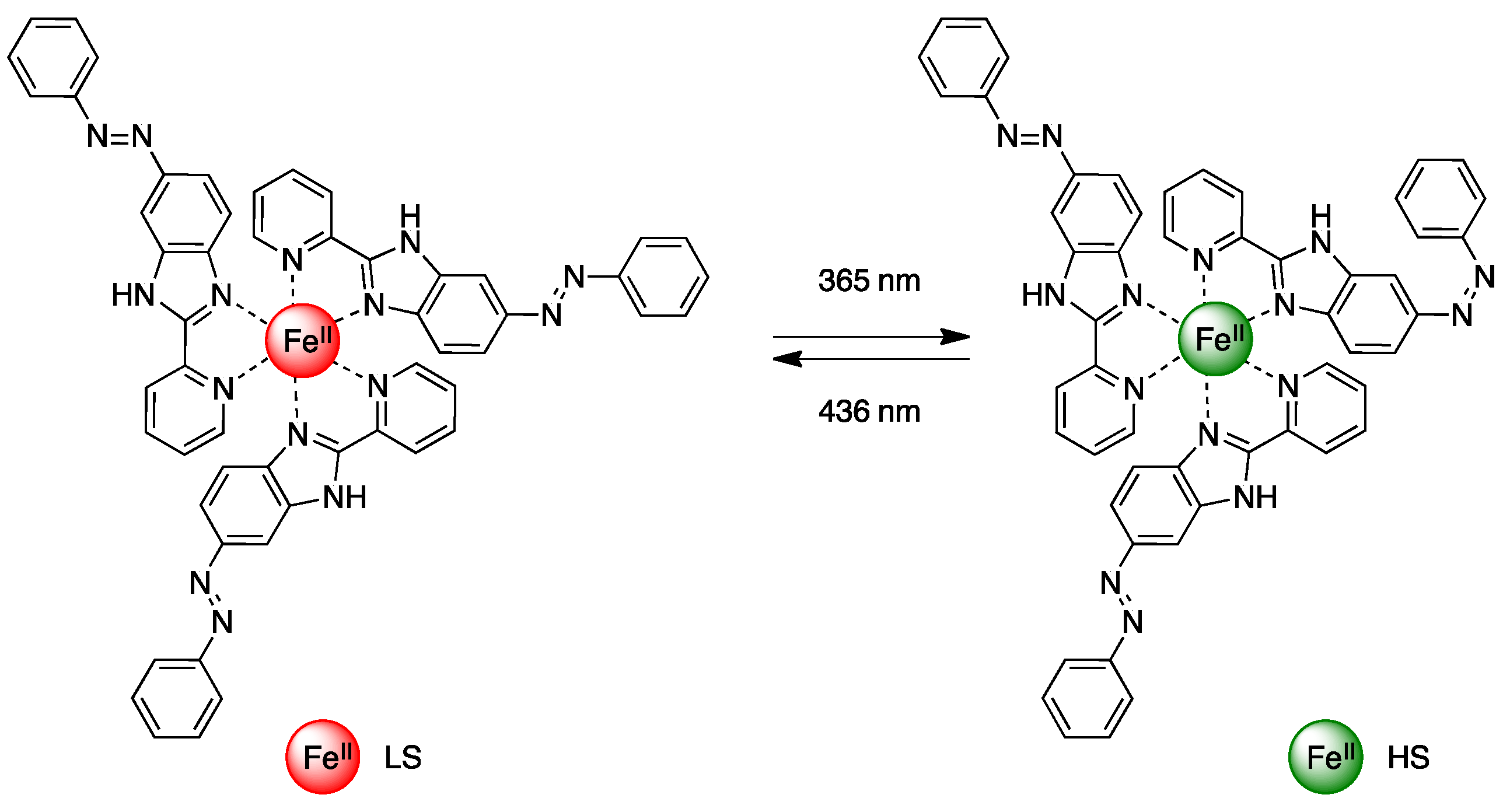








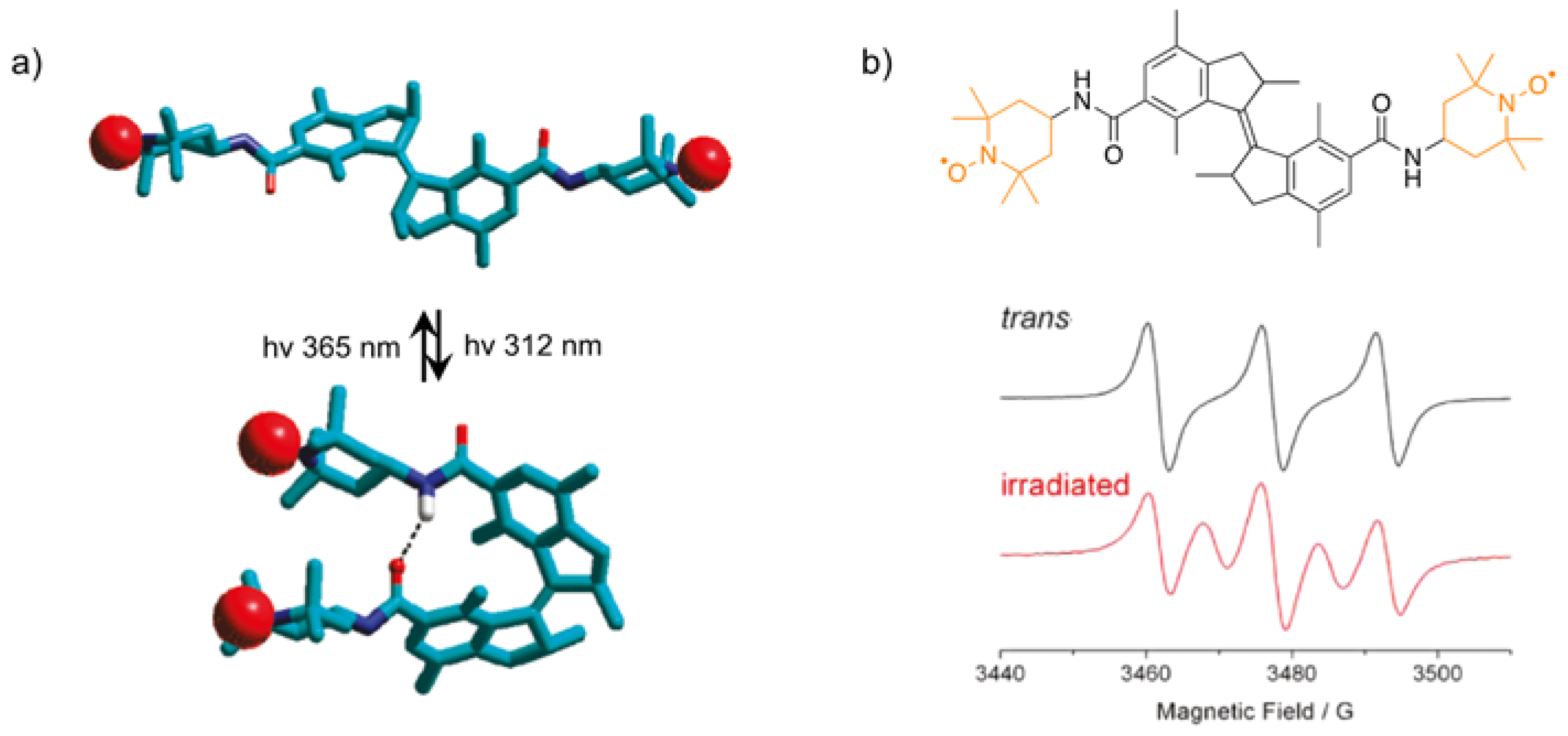
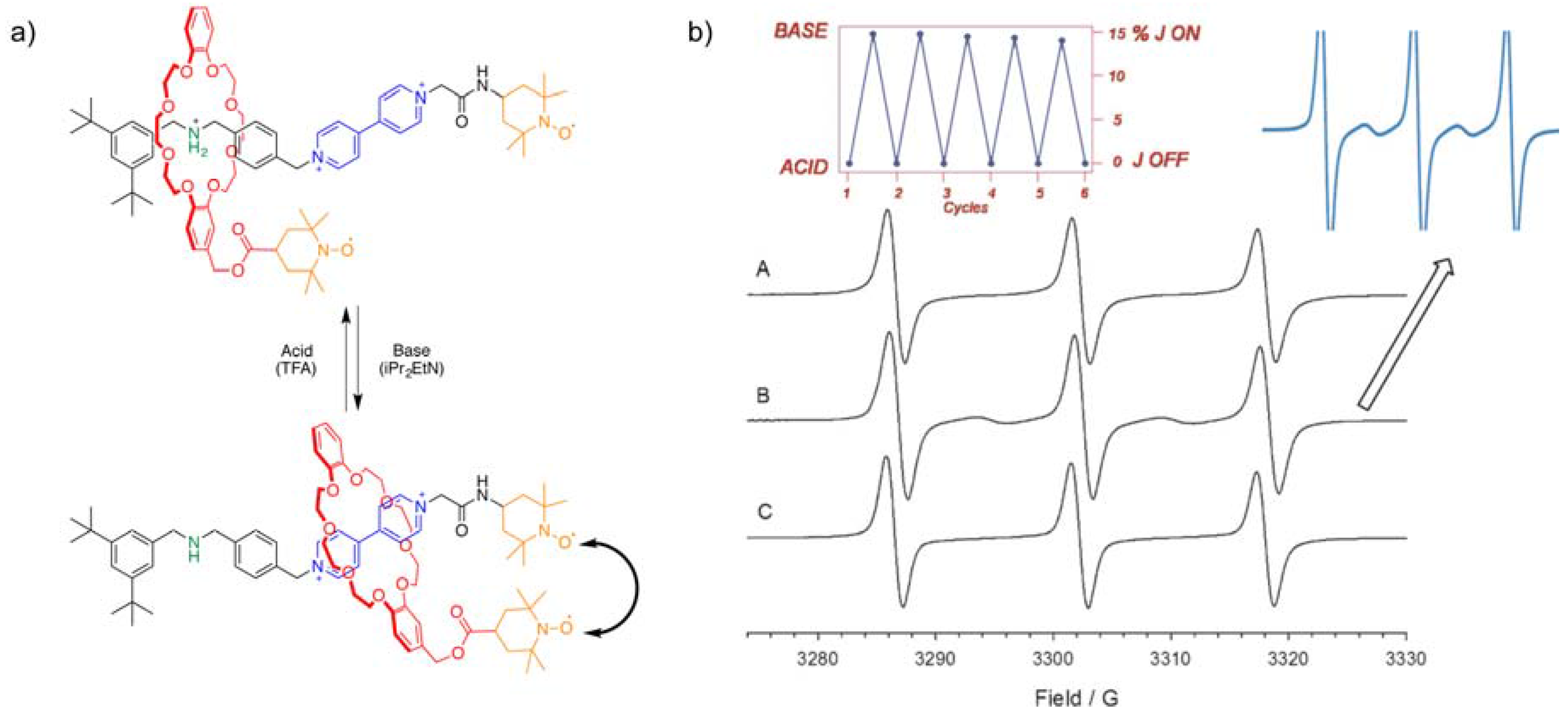
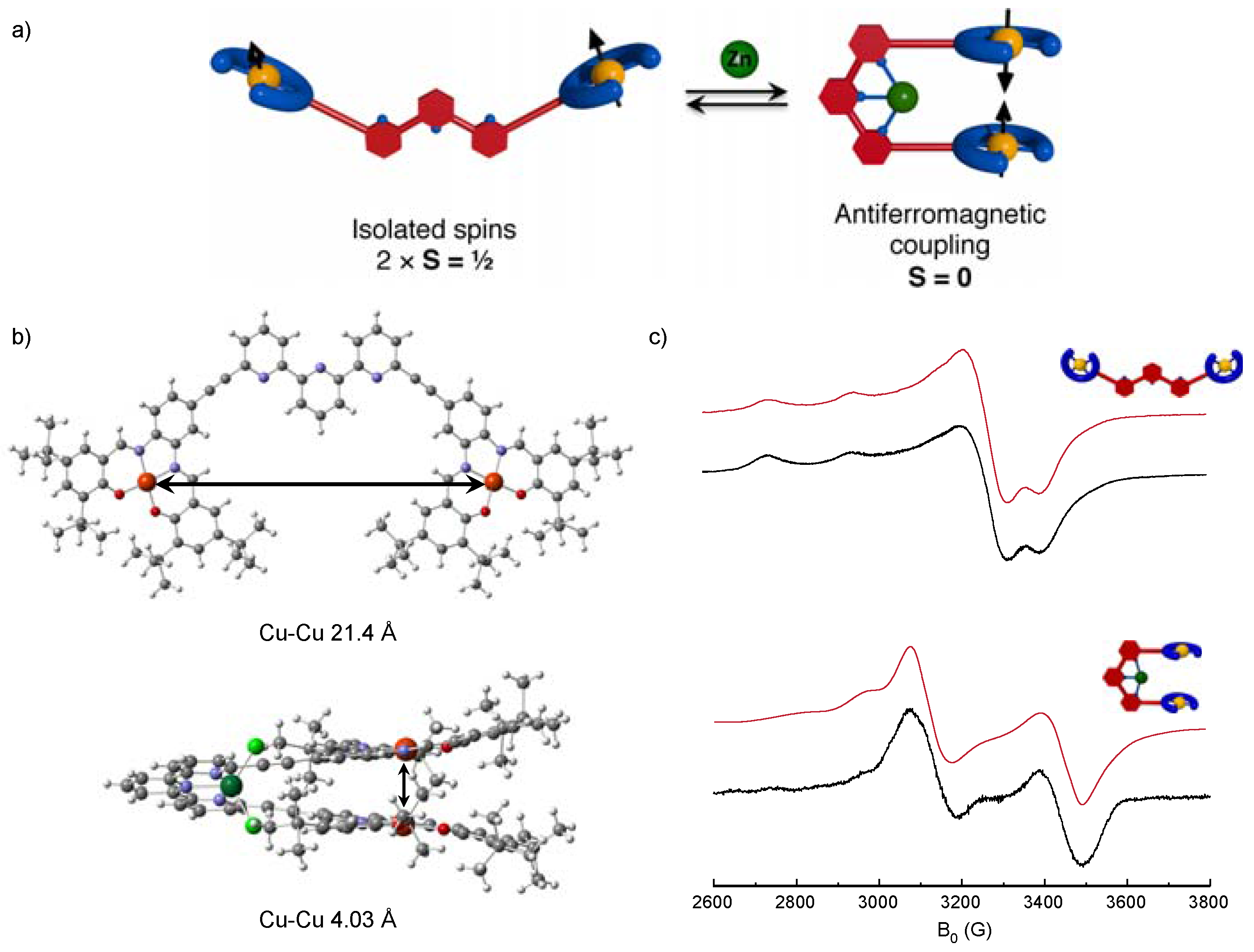
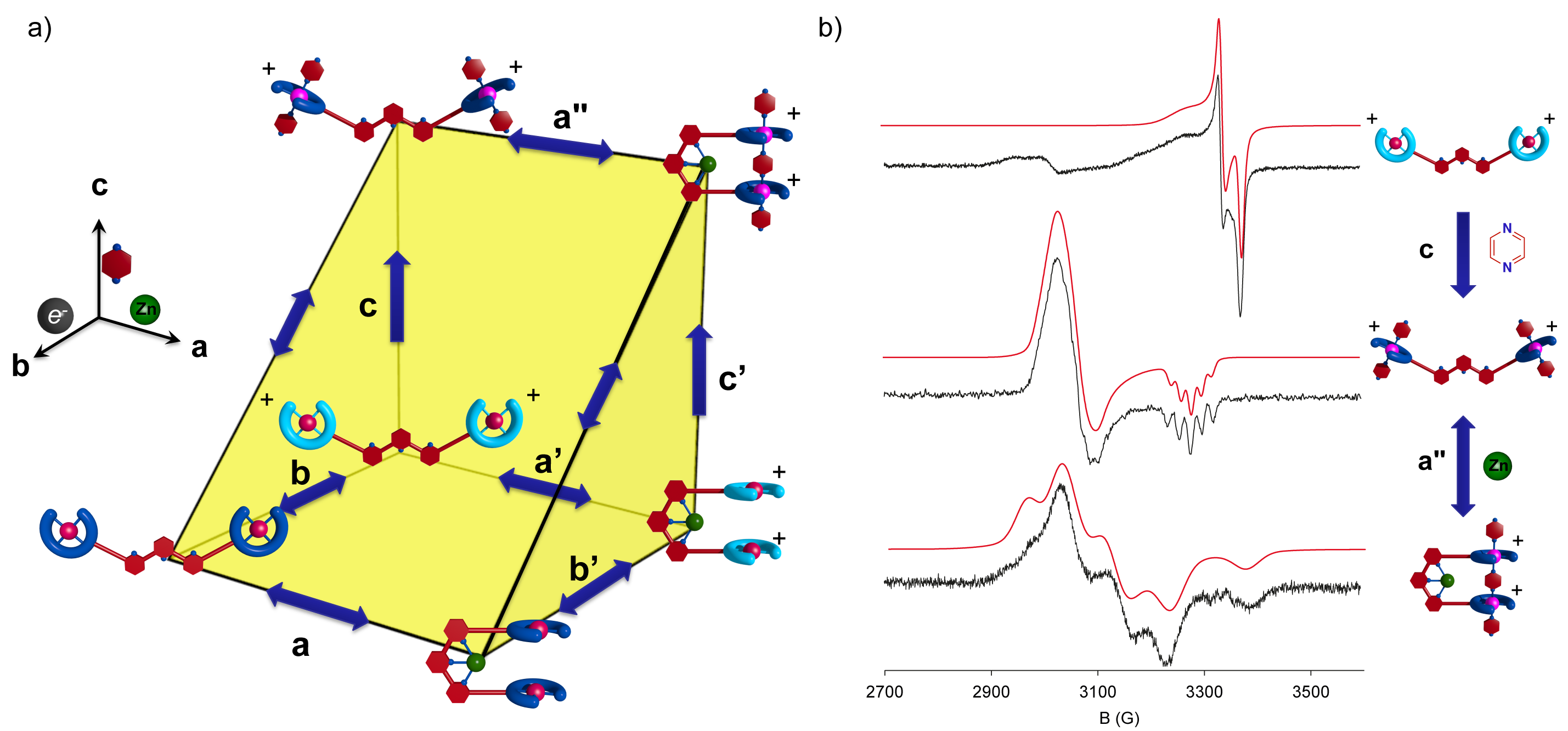
© 2018 by the authors. Licensee MDPI, Basel, Switzerland. This article is an open access article distributed under the terms and conditions of the Creative Commons Attribution (CC BY) license (http://creativecommons.org/licenses/by/4.0/).
Share and Cite
Doistau, B.; Benda, L.; Hasenknopf, B.; Marvaud, V.; Vives, G. Switching Magnetic Properties by a Mechanical Motion. Magnetochemistry 2018, 4, 5. https://doi.org/10.3390/magnetochemistry4010005
Doistau B, Benda L, Hasenknopf B, Marvaud V, Vives G. Switching Magnetic Properties by a Mechanical Motion. Magnetochemistry. 2018; 4(1):5. https://doi.org/10.3390/magnetochemistry4010005
Chicago/Turabian StyleDoistau, Benjamin, Lorien Benda, Bernold Hasenknopf, Valérie Marvaud, and Guillaume Vives. 2018. "Switching Magnetic Properties by a Mechanical Motion" Magnetochemistry 4, no. 1: 5. https://doi.org/10.3390/magnetochemistry4010005
APA StyleDoistau, B., Benda, L., Hasenknopf, B., Marvaud, V., & Vives, G. (2018). Switching Magnetic Properties by a Mechanical Motion. Magnetochemistry, 4(1), 5. https://doi.org/10.3390/magnetochemistry4010005



